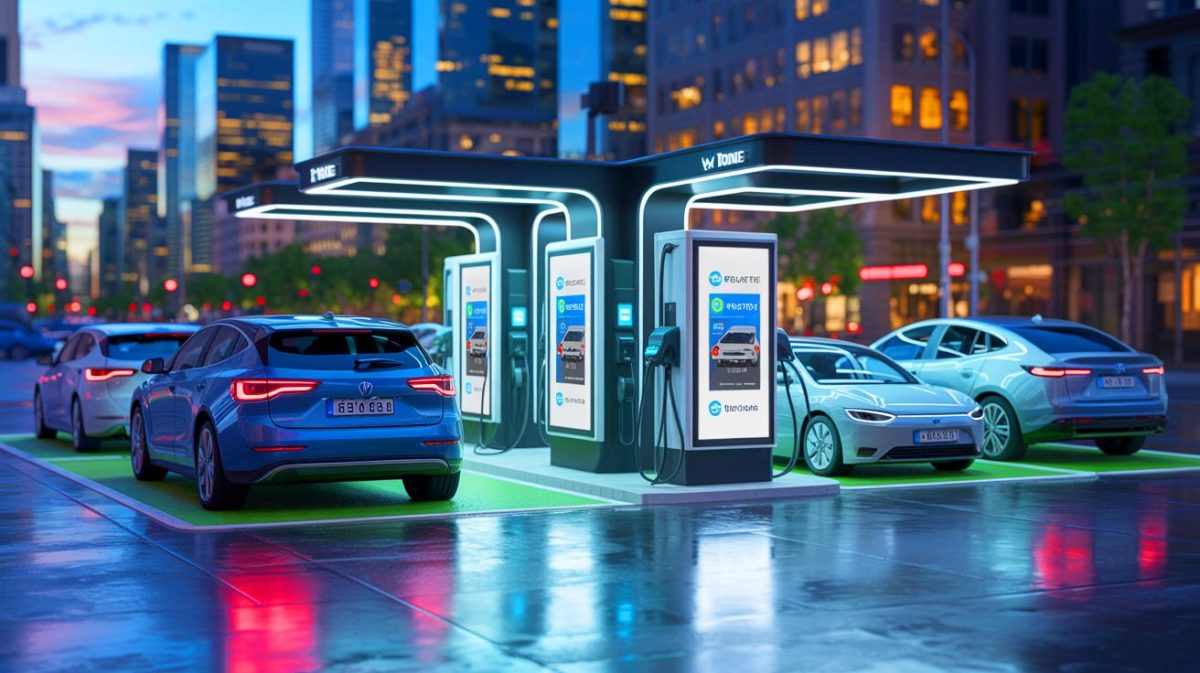| IN A NUTSHELL |
|
The rollout of electric vehicles (EVs) has been accelerating rapidly, creating an urgent need for expanded charging infrastructure across the globe. The introduction of the “EV Totem,” a product by Blink Charging in collaboration with Universal Media, represents a novel approach to addressing this need. This innovative unit combines an EV charging station with dual-sided digital advertising displays, offering a new blend of technology and advertising. As the global electric vehicle market continues its exponential growth, reaching an estimated $6.52 trillion by 2030, solutions like the EV Totem are poised to play a significant role in supporting this expansion.
Integrating EV Charging and Advertising
The EV Totem is not just another charging station. With two 55-inch high-definition screens elevated seven feet from the ground, the unit ensures visibility of digital advertisements even when vehicles are parked in the charging bays. This integration of EV charging with Digital Out-of-Home (DOOH) advertising represents a strategic entry into a market projected to grow to $84.03 billion by 2033. The goal is to transform charging locations into points of interest where consumers engage with targeted advertisements while waiting for their vehicles to charge.
According to Mike Battaglia, CEO of Blink Charging, this innovation aims to create a dynamic media and mobility platform. The EV Totem’s ability to deliver real-time, location-based ad targeting and integrated analytics provides brands and property partners with performance data, enhancing the value and relevance of their advertising efforts. This move is expected to unlock new opportunities not only for advertisers but also for communities and property owners hosting these stations.
The Expanding Landscape of EV Charging Technology
The EV Totem enters the market at a time when significant developments in EV charging technology are taking place globally. The EV charging infrastructure market itself is projected to grow to $125.39 billion by 2030. Innovations like the ‘Electric Vehicle Automatic Charging Robot (ACR)’ by Hyundai and Kia exemplify the industry’s push towards automated solutions. This robotic system, currently being trialed at Incheon International Airport in South Korea, automatically connects and disconnects charging cables, streamlining the charging process.
Moreover, the concept of battery swapping stations, which has gained traction in China, offers another approach to mitigating range anxiety. These stations allow EV users to swap out depleted batteries for fully charged ones in just about 100 seconds, a process significantly faster than traditional charging methods. Such innovations underscore the dynamic and rapidly evolving nature of the EV charging market, highlighting the importance of versatile, multi-functional solutions like the EV Totem.
Economic Implications of the EV Totem
The introduction of the EV Totem carries significant economic implications, particularly as the global electric vehicle market continues to expand. With the market expected to reach over $6.52 trillion by 2030, the demand for robust and efficient charging infrastructure is critical. The EV Totem not only addresses this demand but also introduces a new revenue stream through digital advertising. This dual functionality could incentivize more widespread adoption of EV charging stations, particularly in urban environments where advertising space is highly valued.
Additionally, the analytics capabilities of the EV Totem offer businesses insights into consumer behavior and engagement, potentially transforming how advertising is approached in public spaces. This data-driven strategy aligns with broader trends in marketing, where personalization and real-time engagement are increasingly prioritized. As such, the EV Totem could serve as a model for future developments in both the EV and advertising industries.
Challenges and Opportunities Ahead
While the EV Totem presents numerous advantages, its implementation is not without challenges. The integration of charging infrastructure with digital advertising requires careful consideration of location, demand, and technological compatibility. Ensuring that these units are strategically placed to maximize both charging and advertising potential is crucial. Moreover, the reliance on digital displays introduces considerations around maintenance, energy consumption, and technological obsolescence.
Nevertheless, the opportunities presented by the EV Totem are substantial. By enhancing the functionality of charging stations, these units could play a pivotal role in accelerating the adoption of electric vehicles. As more consumers and businesses recognize the value of such integrated solutions, the potential for widespread deployment increases. The success of the EV Totem could inspire further innovations, paving the way for a more connected and sustainable future in both transportation and advertising.
The introduction of the EV Totem signifies a transformative step in the intersection of technology, transportation, and advertising. As the demand for electric vehicles continues to soar, innovative solutions like the EV Totem are essential for sustaining this growth. However, as the industry evolves, how will businesses and consumers adapt to these changes? What new opportunities will arise from the convergence of charging infrastructure and digital media?
Did you like it? 4.5/5 (23)








Est-ce que les pubs sur les bornes de recharge seront personnalisées en fonction de la voiture que vous conduisez ? 🤔
J’espère que les écrans ne seront pas trop distrayants pour les conducteurs !
Les publicités pendant que je recharge ? Pourquoi pas, tant que ça ne ralentit pas la vitesse de charge. 😊
Est-ce que cela signifie que les bornes de recharge seront gratuites si elles sont financées par la publicité ?
J’adore l’idée d’intégrer la technologie et la publicité, mais combien cela va-t-il coûter aux annonceurs ?
Je suis sceptique sur le fait que les gens veuillent voir des publicités pendant qu’ils chargent leur voiture. 😒
Les écrans seront-ils visibles même par temps ensoleillé ?
Merci pour l’info, ça a l’air d’être une excellente initiative pour les villes surpeuplées !
Je ne suis pas sûr que les annonceurs tirent autant de bénéfices des publicités sur les bornes de recharge.